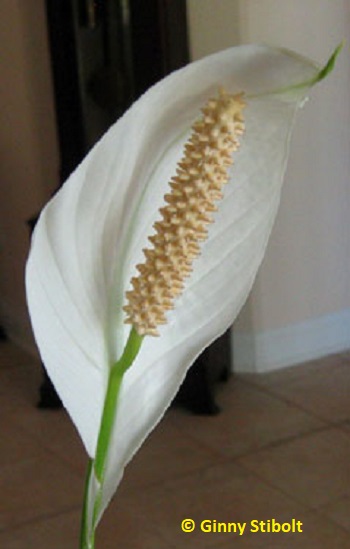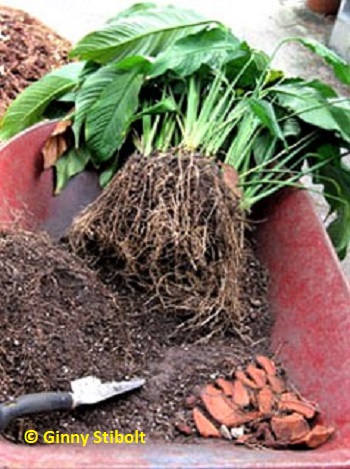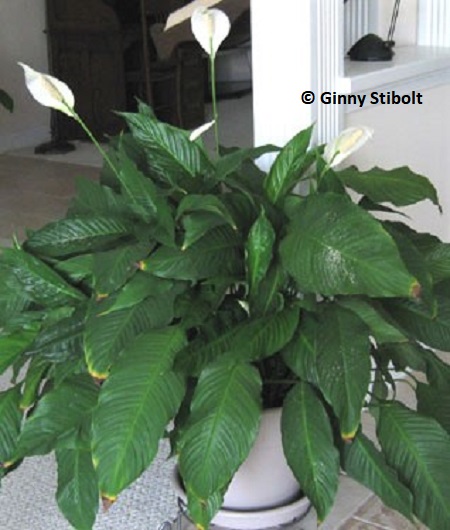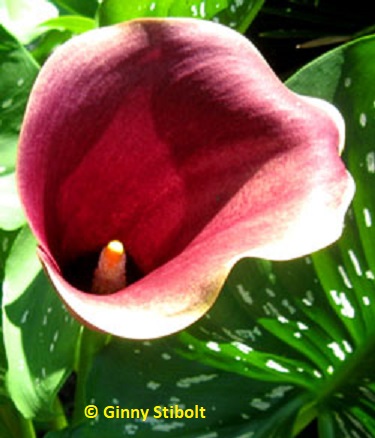|

Give peace (lilies) a chance
by Ginny Stibolt
When we bought our house in 2004, the previous owners left us some porch
plants including two pots of peace lilies (Spathiphyllum sp.).
I'm guessing by their size that we have the 'Mauna Loa' cultivar, one
of the more common peace lilies sold. There are about 40 species of
peace lily distributed throughout tropical Central and South America.
Most hybrids are derived from S. wallisii and S. cochlearispathum.
They are not true lilies, as discussed below, but earned the common
name peace lily or white flag because the modified leaf, called a spathe,
behind the inflorescence (flower head) looks like a white flag of surrender.
Peace lilies are popular, tough houseplants and office plants that
thrive in relatively low light. They are also known for purifying
the indoor air by removing toxic gases such as benzene and formaldehyde. While
all green plants extract carbon dioxide and produce oxygen during photosynthesis,
NASA found 19 houseplants that can grow under low light conditions and
can also absorb various toxic gases that can build up in indoor spaces.
Our peace lilies have graced our porches, but mostly we like them
in the house. Some people say they need to be constantly damp,
but ours get watered only once a week or so. Too much water may cause
root-rot. After more than four years under our care, one of our pots
of peace lilies was wilting too often, had brown tips on its leaves,
and the leaves had lost their typical dark green shine. This winter,
I finally got around to repotting it.
Repotting the peace lily
 When
I tapped the lilies out of the pot, I inspected the roots. As I suspected,
they were root bound and this problem was compounded by the pot's being
only half full of soil and having a lot of potshards in the bottom. When
I tapped the lilies out of the pot, I inspected the roots. As I suspected,
they were root bound and this problem was compounded by the pot's being
only half full of soil and having a lot of potshards in the bottom.
While we've been told over and over again by "gardening experts"
to use a generous layer of potshards or gravel in the bottoms of our
pots to aid drainage, it's simply not true-an
old gardeners' tale. It was shown more than 100 years ago that the flow
of water from the soil is actually impeded when moving from a fine medium
like soil to a coarse medium such as gravel or potsherds. Besides when
you think about it, the plants in a container are under enough strain
already, it just makes sense to provide as much active growing medium
as possible. (See www.informedgardener.com
for more information on this and other horticultural myths.)
So after I tipped the peace lilies from their pot, I untangled the
potsherds from the roots and removed as much soil as I could. Then I
rinsed the roots and leaves with rain barrel water. There was no reason
to retain any of that soil--after years in the pot, it didn't have anything
to offer the plant. I placed the spent soil on top of a compost pile
where it will be rejuvenated as it's incorporated into the compost.
I scrubbed out the same pot with a brush and rain barrel water, placed
a handful of leaves and pine needles in the bottom of the pot to keep
the soil from running through the drainage hole, and filled the pot
halfway with finished compost. I then placed the whole group of plants
back in the pot. I could have separated some of them out to start a
new pot, but since there will be much more soil than before, I didn't
think it was necessary to reduce the mass of plants. From what
I've read, peace lilies prefer a crowed pot. Finally, I filled in and
around the roots with more compost and added a generous amount of water
as I was filling in to prevent large air spaces. 
This same pot a few months later has lots of new growth
and is flowering. The yellow/brown tips on the old leaves still show,
but the new leaves look great. The male flowers are now in bloom and
their nearly white pollen is sprinkled on the leaves below the flowers. >>
The Araceae family
Peace lilies are not true lilies, which have six tepals as we discussed
in A plant by any common name, but are
part of the Araceae plant family also known as Arums. The flowers are
grouped in an inflorescence mounted on a thick stalk, which is underlain
or surrounded by a spathe. The spathe can be relatively flat as
in the peace lily or it can wrap around the inflorescence like the calla
lily (Zantedeschia aethiopica). The spathe can also be shaped
like a hood as in a jack-in-the-pulpit (Arisaema sp.). The
whole flowering structure is called a spadix.
 <<
The spathe on this calla lily is an attractive burgundy with
a golden border. Ever since I first heard Katherine Hepburn say, "The
calla lilies are in bloom again..." in the movie "Stage Door,"
I've wanted to have some in my garden. Here in north Florida, our climate
is perfect for these beauties. Their spotted, arrow-shaped leaves are
also attractive. <<
The spathe on this calla lily is an attractive burgundy with
a golden border. Ever since I first heard Katherine Hepburn say, "The
calla lilies are in bloom again..." in the movie "Stage Door,"
I've wanted to have some in my garden. Here in north Florida, our climate
is perfect for these beauties. Their spotted, arrow-shaped leaves are
also attractive.
Most members of the Araceae family contain oxalate crystals, which
are irritants and may be toxic. Ironically the tubers and roots of some
members of this family such as wild taro (Colocasia esculenta)
have been extensively used as a basic food. It must be dried and
cooked to break up the crystals. Taro was imported from India to feed
the slaves and now it's one of Florida's most invasive weeds.
Other members of this widespread and well-known family include: athuriums
(Anthurium andreanum), skunk cabbage (Symplocarpus foetidus),
dieffenbachia (Dieffenbachia picta), philodendrons (Philodendron
spp), monstera (Monstera spp), Chinese evergreens (Aglaonema
spp), caladiums (Caladium spp), and many others.
Philodendrons, Chinese evergreens, and dieffenbachia were also included
in the NASA study and can all remove toxins from the air.
Peace lilies are great office & house plants
I hope you'll try some beautiful peace lilies in your home or office,
and as an extra bonus they'll remove toxins from your indoor air.
When they need repotting, they'll tell you like mine did. And when they
are happy they'll reward you with their shiny dark green leaves and
their striking, white flag flower heads. Peace!
|



 When
I tapped the lilies out of the pot, I inspected the roots. As I suspected,
they were root bound and this problem was compounded by the pot's being
only half full of soil and having a lot of potshards in the bottom.
When
I tapped the lilies out of the pot, I inspected the roots. As I suspected,
they were root bound and this problem was compounded by the pot's being
only half full of soil and having a lot of potshards in the bottom.
 <<
The spathe on this calla lily is an attractive burgundy with
a golden border. Ever since I first heard Katherine Hepburn say, "The
calla lilies are in bloom again..." in the movie "Stage Door,"
I've wanted to have some in my garden. Here in north Florida, our climate
is perfect for these beauties. Their spotted, arrow-shaped leaves are
also attractive.
<<
The spathe on this calla lily is an attractive burgundy with
a golden border. Ever since I first heard Katherine Hepburn say, "The
calla lilies are in bloom again..." in the movie "Stage Door,"
I've wanted to have some in my garden. Here in north Florida, our climate
is perfect for these beauties. Their spotted, arrow-shaped leaves are
also attractive.